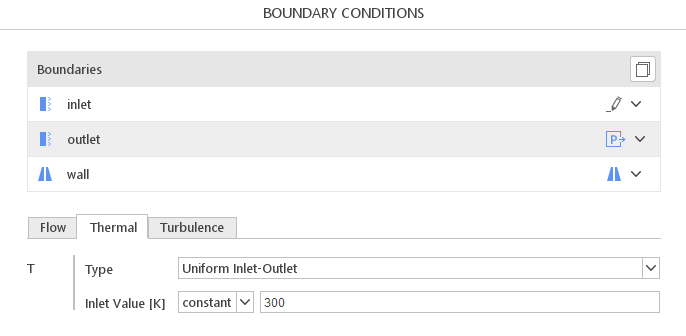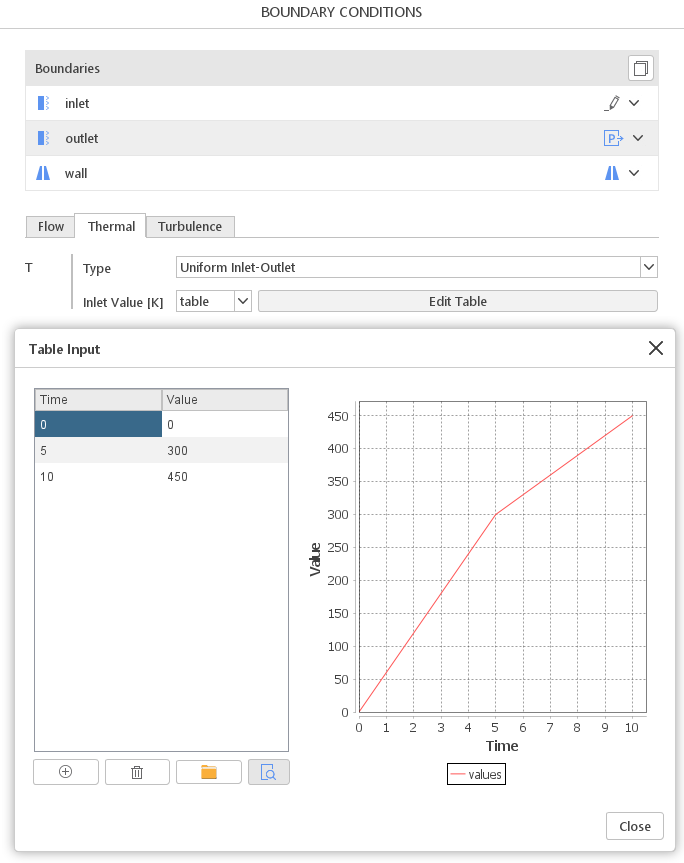Uniform Inlet-Outlet - Boundary Condition Description
Uniform Inlet-Outlet is a derivative of Inlet Outlet. The boundary condition is used to specify a variable that acts as both an inlet and an outlet at a particular boundary of a computational domain. It is commonly employed for variables such as velocity or mass flow rate, where the value can vary depending on the flow conditions.
The Uniform Inlet-Outlet boundary condition allows for a smooth transition between an inflow and an outflow boundary. It is particularly useful when you have a boundary that can switch between behaving as an inlet or an outlet, depending on the local flow direction. Uniform Inlet-Outlet boundary condition can be applied to all variable types (scalars, vectors, etc.).
Compared to Inlet Outlet, the Uniform Inlet-Outlet definition allows setting the value as a constant value or time-dependent.
Uniform Inlet-Outlet - Boundary Condition Understanding Uniform Inlet-Outlet
Uniform Inlet-Outlet can be represented graphically, as in the image below.
Illustration below depicts that if the flux is out of the domain, the Uniform Inlet-Outlet behaves as the Zero Gradient boundary condition. However, if the flow conditions change and the flow is inward (towards the domain), the Fixed Value boundary condition is applied.

Uniform Inlet-Outlet - Boundary Condition Application & Physical Interpretation
The Uniform Inlet-Outlet boundary condition is designed to efficiently handle flow at boundaries where the direction of flow can potentially reverse, making it particularly suitable for domains where inflow and outflow conditions are not strictly predefined. This boundary condition is adaptive, meaning it changes its behavior based on the local flow conditions at the boundary. Below are a few examples demonstrating how this boundary condition can be used and how to correctly interpret its meaning.
Uniform Inlet-Outlet in Aerodynamics applications
Example applications: car, aircraft aerodynamics, wind tunnel experiment
This problem can be solved by using simpleFoam (solver). The velocity boundary condition at the outlet can be defined as Uniform Inlet-Outlet. This is critical because, in the wake of the motorbike (or any other object), flow regions might experience reverse flow due to vortices or turbulent eddies.
| Physics | Velocity | Pressure |
|---|---|---|
Outflow | Uniform Inlet-Outlet | Fixed Flux Pressure |
Uniform Inlet-Outlet in VoF (Volume of Fluid) applications
Example applications: free surface flows, ship hull calculations, sloshing, ship hydrodynamics, wave impact on structures
For flows with a distinctive interphase between two fluids, like water and air (Volume of Fluid method used in interFoam (solver)) Uniform Inlet-Outlet boundary condition for a volume fraction \(\alpha\) can be applied for so-called atmospheric boundaries of the domain, above the free surface. It will allow in this situation the air entrainment into the domain.
| Physics | Velocity | Pressure | Phases \(\alpha\) |
|---|---|---|---|
Pressure Outlet | Pressure Inlet-Outlet Velocity | Fixed Value | Uniform Inlet-Outlet |
Uniform Inlet-Outlet in Heat Transfer applications
Example applications: room ventilation, room heating, electronic cooling, atmospheric flows
Buoyancy-driven flows with heat exchange can be simulated in the buoyantPimpleFoam (solver). The Uniform Inlet-Outlet boundary condition for temperature T can be applied to the outlet out of the domain - again to prevent the backflows/reverse flows that might appear due to changing operating conditions.
| Physics | Velocity | Pressure | Thermal - T |
|---|---|---|---|
Pressure Outlet | Pressure Inlet-Outlet Velocity | Fixed Value | Uniform Inlet-Outlet |
Uniform Inlet-Outlet - Boundary Condition How to apply Uniform Inlet-Outlet in SimFlow
Constant Value in Uniform Inlet-Outlet
When the constant value of variable is assigned using Uniform Inlet-Outlet boundary condition, the definition is similar to Inlet Outlet.

Time-dependent value in Uniform Inlet-Outlet
The variable can be defined also as time-dependent. In SimFlow the convenient table with graphical representation is used to define the boundary condition.

Uniform Inlet-Outlet - Boundary Condition Uniform Inlet-Outlet - Alternatives
In this section, we propose boundary conditions that are alternative to Uniform Inlet-Outlet. While they may fulfill similar purposes, they might be better suited for a specific application and provide a better approximation of physical world conditions.
| Boundary Condition | Description |
|---|---|
similar to Zero Gradient but with an additional feature, which prevents so-called backflows | |
prescribes normal gradient to zero | |
Pressure Inlet-Outlet | allows velocity to adjust at the outlet in order to satisfy the prescribed inlet velocity |